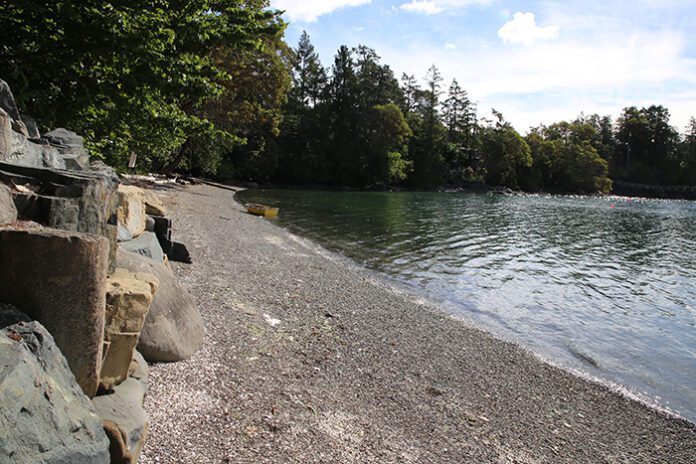A statistical artefact is to blame for regional officials keeping a water quality advisory in place for more than a month at one Salt Spring Island beach, despite most tests there returning with barely detectable amounts of bacteria.
The Capital Regional District (CRD) and Island Health are keeping an advisory in place for Churchill Beach, even after the third water test in a row –– June 12, 18 and now July 9 –– returned with “LT5” or less than five enterococci bacteria per 100 mL of seawater tested, according to the health department’s data.
Enterococci are indicator bacteria Island Health uses to identify the presence of fecal contamination and determine potential risk associated with swimming. On June 11, one week after a water sample taken at Churchill Beach on June 4 showed 85 bacteria per 100 mL, the CRD and Island Health issued a warning to not only avoid swimming there but also to “keep animals on a leash to prevent them from ingesting or swimming in the water” until the advisory was lifted, according to a CRD release.
That abnormally high reading had come after a May 22 reading of “LT5.” It’s not clear what might’ve led to the high reading June 4, but Island Health considers saltwater beaches “acceptable” when single sample enterococci results are less than or equal to 70 per 100 mL –– above which there is considered a “significant risk of illness” from entering the water, according to officials.
Unfortunately, the other threshold Island Health considers is whether the average of the most recent five tests finds fewer than 35 of the bacteria per 100 mL sample; in this case, the four “LT5” tests with the single test showing 85 will average out to 37.
Both Churchill Beach and the other nearby testing spot for Ganges Harbour at the Centennial Park bulkhead showed “LT5” July 9, according to Island Health data.
The addition of testing for salt water at Ganges Harbour to what had in previous years only been a freshwater testing program was requested last year by a group supporting the Clean and Safe Harbour Initiative (CASHI), which advocates regulating liveaboards in Ganges Harbour partly over concerns human waste was being discharged there by people living afloat.
Regular testing at popular swimming lakes on Salt Spring on July 9 — for E. coli, the indicator bacteria used for fresh water — at St. Mary, Cusheon and, Blackburn lakes all came back satisfactory, at or below five per 100 mL.
At Stowel (aka Stowe) Lake the reading was 15, and at Weston Lake 14.
For E. coli, a warning is typically issued when results exceed 400 counts per 100 mL, or when the most recent five samples average greater than 200.

